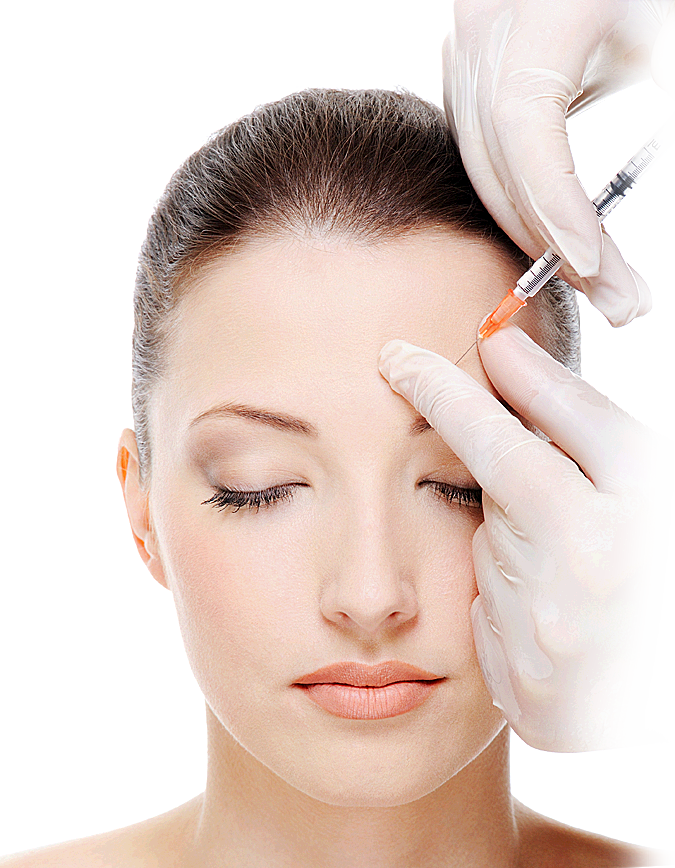
Botox
Botulinum toxin A has been used in medicine for many years now, mostly as a proven substance in neurology and ophthalmology. The cosmetic medicine has begun making use of the amazing properties of this substance for smoothing out the wrinkles and, more recently, for treating excessive sweating.
The current state of knowledge allows us to call botulinum a neurostimulant rather than a toxin. The doses used in the cosmetic medicine are minimal and there are no concerns about safety. The results, the effectiveness and the simple character of the procedure are very satisfying for patients. They do not alter the face just very naturally rejuvenate its look.
Indications
Primarily the wrinkles in the upper part of the face:
- between eyebrows - “lion’s wrinkles”
- horizontal wrinkles on the forehead
- wrinkles around eyes - “crows’ feet”
- lower part of the face:
- wrinkles around the mouth
- chin
- Neck
How does smoothing wrinkles with botulinum toxin treatment work?
The application of the botulinum toxin does not require the patient to prepare in any particular way. It is carried out in a single session and does not hinder the patient in their everyday duties. The duration is about 20 minutes. The substance is injected into the area near the wrinkle with a very thin needle. The exact places of application are planned beforehand. The patients have a high tolerance to the procedure and do not require anesthesia. In one session the patient receives a few dozen units of the substance; the dose in cosmetic medicine is several times lower than the medicinal dose and is completely safe.
The botulinum toxin becomes active after about 72 hours and the full effect of the treatment becomes visible after 14 days and lasts 3-6 months. This time depends on patient’s individual biological characteristics. Once botulinum has become inactive, the procedure may be repeated. However, even with patients who, for various reasons, cannot undergo another treatment, the skin continues to look favorable. Already after a single treatment, i.e. after about half a year of the activity of the botulinum toxin the skin looks younger, better rested. Very often the wrinkles become shallower.
The delayed activation of the medicine is definitely an advantage of this method. It allows the patient to gradually become accustomed to the new look of the skin. The skin becomes smooth but is free of the mask-like look. The treatment may be repeated multiple times. With regular repetitions the activation period of the substance sometimes becomes longer.
Can everybody undergo the botulinum toxin treatment?
The botulinum toxin treatment should not be carried out with pregnant women and during the lactation period.
Other, rare contraindications are:
- neuromuscular conductivity disorders (myasthenia gravis, Lambert-Eaton syndrome, myopathies, degenerative changes in lateral funiculi)
- epilepsy
- multiple sclerosis
- hypersensitivity to the substance ingredients (human-derived albumins)
- current use of the following medicinal substances or the period of up to a week after stopping: aminoglycosides (streptomycin, gentamicin, amikacin, kanamycin etc.), aminochinolons (chloroquine, hydroxychloroquine), D-penicillamine (Cuprenil), cyclosporine, tubocurarine, pancuronium, gallamine, succinylcholine, lincomycin, tetracycline, polymyxin
- topical skin infections
- blood coagulation disorders
- use of blood thinners (e.g. aspirin, acenocumarol) - stop using about 7 days prior, after consulting your doctor
- Botulinum toxin A allergy or allergy to human-derived albumin
- neuromuscular junction diseases (myasthenia gravis, amyotrophic lateral sclerosis, Lambert-Eaton syndrome);
- use of aminoglycoside antibiotics (e.g. gentamicin)
- extensive skin lesions
- prior facial plastic surgeries, also involving silicon
Is the botulinum toxin treatment safe?
It is safe. Any side effects occur very seldom (the percentage of complications is lower than 3%) and, most importantly, are temporary.
Side effects
The pain related to the injection - generally minimal, does not require anaesthesia
- a small bruise located at the injection site - rare, is re-absorbed within a few days
- excessive or insufficient activity of the botulinum toxin - it can cause asymmetry, excessive lowering or raising eyebrows, lowering of the eyelid - when the treatment is performed by an experienced doctor, these symptoms are very rare, temporary, and in some cases can be corrected during another procedure
- headache after the procedure - rare, passes within a few hours.
